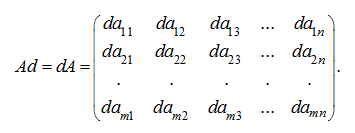|
Matrix Algebra - Operations with matrices
Operations with matrices
1. Equality of matrices
Two matrices
 of the same dimensions
of the same dimensions
 are considered equal:
А
=
В
, if their appropriating elements are equal, that is
are considered equal:
А
=
В
, if their appropriating elements are equal, that is

2. The sum and difference of matrices
The
sum
of two matrices
 of the same dimensions
of the same dimensions
 is called the matrix
is called the matrix
 of the same dimension which elements are equal to the sum of appropriating elements of the matrices
A
and
B
.
of the same dimension which elements are equal to the sum of appropriating elements of the matrices
A
and
B
.
From the definition of the sum of matrices its basic properties directly follow:
1)
А+В = В+А
;
2)
А+(
В+С
) = (
А+В
)+С
;
3)
А
+
0
=
А
.
The
difference
of matrices
A
and
B
is defined similarly.
3. Multiplication of a matrix to number
The
product
of a matrix
A
on number
d
(or product of number
d
on a matrix
A
) is called the matrix, which elements are products of a matrix
A
elements on a number
d
. Differently,

From the definition of product of number on a matrix its basic properties directly follow:
1) 1
А
=
А
1=
А
;
2) 0
А
=
А
0=0 ;
3)
d
(
hA
) = (
dh
)
A
=
h
(
dA
) ;
4) (
d+h
)
A=dA+hA
;
5)
d
(
A+B
) =
dA+dB
.
Here
A
and
B
– matrices,
d
and
h
– numbers.
Let's notice, that for the order
n
square matrix
A
the equality takes place:

The matrix –
A
= (–1)
A
is called
opposite
. Apparently, that for two matrices
A
and
B
of an identical dimension the equality takes place:
A
–
B
=
A
+ (–
B
).
4. Multiplication of matrices
Let dimensions of matrices
A
and
B
are equal accordingly to
m
×
n
and
n
×
k
, that is the number of columns of a matrix
A
is equal to number of rows of a matrix
B
, then for these two matrices the matrix
C
of dimension
m
×
k
is certain, being their product:
C = АВ
. Elements of a matrix
C
are calculated under the formula:

From here it follows, that
the element costing in i-th row and j-th column of a matrix-product, is equal to the sum of products of elements of i-th row of the first matrix on appropriating elements of j-th column of the second matrix.
From the definition of product of matrices it follows, that
it is possible to multiply square matrices only of the same orders
.
The basic properties of matrix product:
1)
А
(
ВС
)
=
(
АВ
)
С
;
2)
d
(
АВ
) = (
dA
)
B
;
3) (
А+В
)
С= АС+ ВС
;
4)
С
(
А+В
)
= СА+ СВ
.
Here
A
,
B
and
C
– matrices,
d
– a number.
The
product
of two matrices generally is not commutative
, that is
AB ≠ BA
. In that specific case, when
AB
=
BA
, matrices
A
and
B
are called
commutative
(permutable). As it is easy to make sure, an identity matrix
E
is commutative with any square matrix of the same order, and
AE
=
EA
=
A
. Consequently, at multiplication of matrices an identity matrix
E
plays the same role, that unit at multiplication of numbers.
For square matrixes
A
and
B
of the same orders the equality takes place: det (
AB
) = det (
BA
) = det
A
· det
B
.
E x a m p l e . The matrices are given

Calculate determinants of left and right products
АВ
and
ВА
.
S o l u t i o n .

or it is final:

that is
AB ≠ BA
.
However, determinants of products
АВ
and
ВА
are equal:

|



